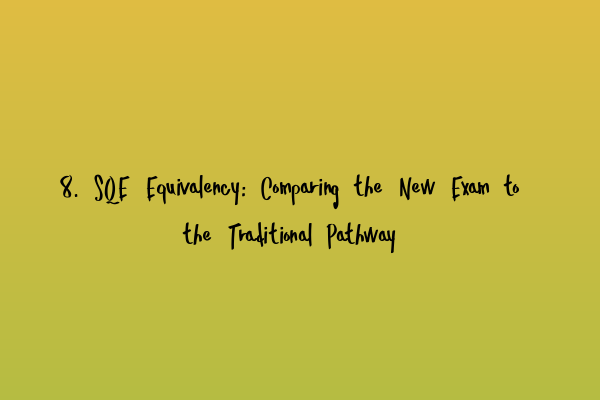As a solicitor, writer, and SEO expert at SQE Exam Law, I understand the importance of providing detailed information about the new Solicitors Qualifying Examination (SQE) and how it compares to the traditional pathway. In this blog post, I will delve into the intricacies of the SQE and provide valuable insight for those considering this new route to becoming a solicitor. So, let’s get started!
Before we dive into the meat of the topic, it’s worth familiarizing ourselves with the SQE. The SQE is a new examination introduced by the Solicitors Regulation Authority (SRA), which is set to replace the current route to qualification as a solicitor in England and Wales. Under the traditional pathway, aspiring solicitors would undertake a combination of academic study, vocational training, and a training contract. However, the SQE offers an alternative route for individuals seeking qualification.
1. Understanding the SQE Structure:
The SQE is divided into two parts – SQE1 and SQE2. SQE1 focuses on testing candidates’ legal knowledge and is further divided into two stages. Stage 1 consists of multiple-choice questions (MCQs) and is a computer-based test. To help you prepare for SQE1, you can find practice exam questions here: SQE 1 Practice Exam Questions. Stage 2 of SQE1 includes written tasks, such as legal research and writing, client interviewing, and case analysis.
After successfully completing SQE1, candidates move on to SQE2, which concentrates on assessing practical legal skills. SQE2 consists of a series of assessments, including simulated client interviews, advocacy, and legal drafting.
2. Benefits of the SQE:
Now, let’s explore some of the advantages that the SQE brings to the table:
– Flexibility: Unlike the traditional pathway, the SQE allows candidates to choose when and where to sit the exams. This provides greater flexibility and control over the pace of your training.
– Cost-Effective: The SQE can be a more cost-effective option for many individuals. By breaking down the qualification process into separate assessments, candidates can spread the cost over time, rather than paying for an entire training contract upfront.
– Widening Access: The SQE aims to increase diversity and widen access to the legal profession. Its modular structure allows candidates to qualify based on merit rather than socioeconomic background, making it more inclusive.
3. Comparing the SQE to the Traditional Pathway:
Now, let’s compare the SQE to the traditional pathway for qualifying as a solicitor:
– Academic Requirements: Under the traditional pathway, candidates are required to complete a qualifying law degree or, alternatively, a non-law degree followed by the Graduate Diploma in Law (GDL). The SQE, on the other hand, does not have any specified academic requirements. As long as you pass the SQE assessments, you are eligible to qualify as a solicitor.
– Vocational Training: While the traditional pathway requires candidates to complete the Legal Practice Course (LPC), the SQE does not have a specific vocational training course. However, it is worth considering undertaking SQE2 preparation courses to ensure you are fully prepared for the practical assessments. You can find more information about SQE2 preparation courses here: SQE 2 Preparation Courses.
– Training Contract: Another key difference between the two pathways is the requirement for a training contract. Through the traditional route, candidates must secure a training contract with a law firm, whereas the SQE pathway does not require a training contract. Instead, candidates can gain practical experience through work placements, pro bono work, or alternative means.
– SQE Exam Dates: If you are considering the SQE route, it is essential to keep an eye on the upcoming exam dates. You can find the latest information about the SRA SQE Exam Dates here: SRA SQE Exam Dates.
4. Preparing for the SQE:
To best prepare for the SQE, practice is key. It is highly recommended to take advantage of practice mocks, such as FLK1 and FLK2, for SQE1. You can find more information and access practice mocks here: SQE 1 Practice Mocks FLK1 FLK2. Additionally, undergoing SQE1 preparation courses can significantly enhance your chances of success. You can explore SQE1 preparation courses here: SQE 1 Preparation Courses.
In conclusion, the new SQE offers an alternative route to qualification as a solicitor. With its modular structure, flexibility, and cost-effectiveness, it opens doors for aspiring solicitors from diverse backgrounds. Although the SQE differs from the traditional pathway, both routes have their own unique advantages. By understanding the intricacies of the SQE and making use of practice materials and preparation courses, you can set yourself up for success in this new era of legal education and qualification.
I hope this blog post has shed light on the SQE and its equivalency to the traditional pathway. For further information and guidance, please feel free to browse the SQE resources on our website SQE Exam Law.
